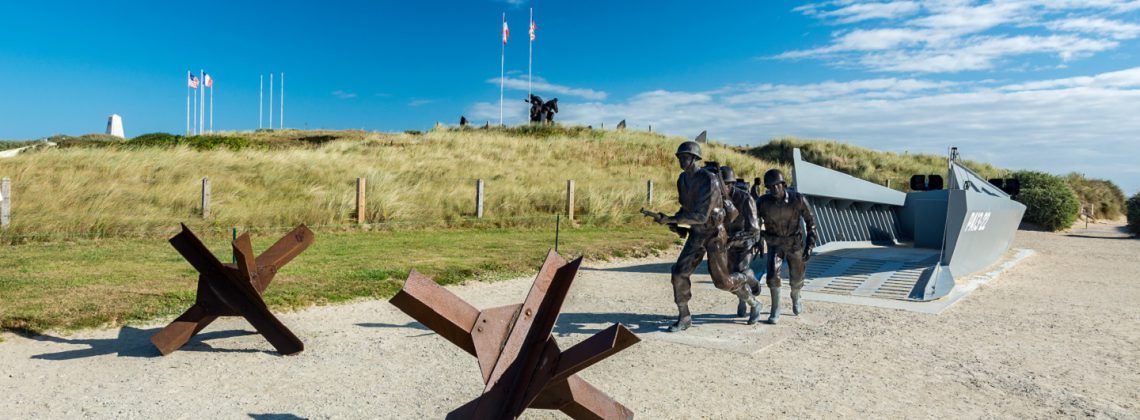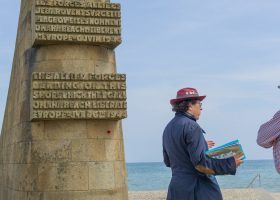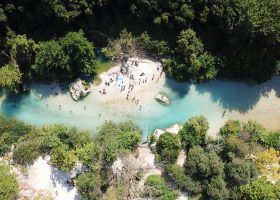D-Day, June 6, 1944, was one of the most pivotal days in world history. That day, thousands of Allied troops began their liberation of “the oppressed peoples of Europe,” as then-General Dwight D. Eisenhower put it. Today, you can explore this important place in history from Omaha and Utah Beaches to the American Cemetery and Point du Hoc. In this article, I’ll tell you about the top must-see sites at the Normandy D-Day beaches.
Pro Tip: Planning what to do on your trip to Paris? Bookmark this post in your browser so you can easily find it when you’re in the city. Check out our guide to Paris for more planning resources, our top Normandy tours for a memorable trip, and if a Normandy tour is worth it.
What You Have to See at the Normandy D-Day Beaches
“Your task will not be an easy one,” Eisenhower wrote to the Allied troops. Those words were part of his now-famous official order for the June 6, 1944, D-Day invasion. Indeed, it was not easy. In fact, according to the US Department of Defense, 4,700 of the 35,000 soldiers who first went ashore that day were wounded, killed, or declared missing.
The huge D-Day operation included the invasion and the push through Normandy then southeast to Paris. The invasion architects who selected Normandy as the landing zone gave it the codename Operation Overlord.
Gaining a strategic foothold in northwest Europe was essential to turning the tides in the war. Allied troops landing in Normandy were extremely vulnerable. The Germans had established positions, including bunkers, along the coast. They had also occupied cities such as Caen, the capital of Normandy.
Eisenhower warned the troops, “Your enemy is well-trained…He will fight savagely.” Therefore, it was up to the Allied forces to liberate the land and the French people. The battle that turned the tides of World War II started in Normandy.
In this article, I will explain why 50 miles of coastline in Normandy—which includes specific areas you can visit—held the key to victory. Here are 8 important sites from the Caen Memorial Museum to La Pointe du Hoc you won’t want to miss.
Not ready to book a tour? Find out if a tour of Normandy’s D-Day beaches are worth it.
8. Caen Memorial Museum
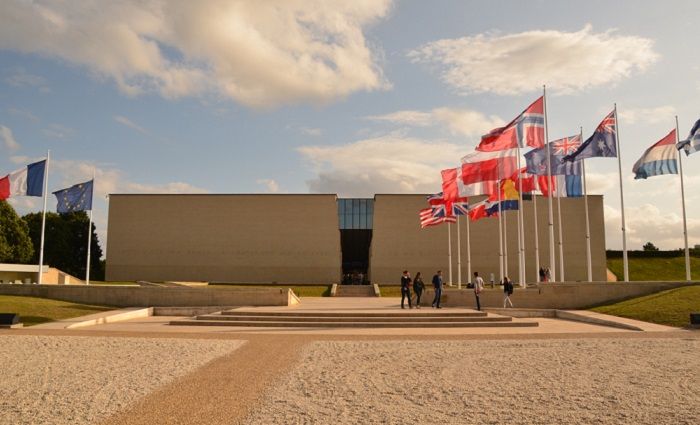
I recommend starting your Normandy D-Day Beaches visit in Caen. Caen is about 10 miles inland from the English Channel. It is the largest city in Normandy and played a crucial role in the war as it has in days past, such as when William the Conqueror once used Caen as his capital. It was heavily bombed by the Germans during World War II, and the city lost numerous historical buildings entirely.
The Caen Memorial Museum provides visitors with a comprehensive picture of the war in this part of France. Different areas of the museum tell different stories, so be sure to allow plenty of time here.
For example, you’ll learn about how civilians coped with the German Occupation. You’ll see objects related to the French Resistance, which was extensive. Finally, you’ll hear the stories of D-Day and the Battle of Normandy. The Caen Memorial Museum is the perfect place to get a full understanding of what you’ll see here at the Normandy D-Day Beaches before you head to Omaha Beach.
Address: Esp. Général Eisenhower, 14050 Caen
Cost: starting at €17.50
7. Bayeux Battle of Normandy Museum
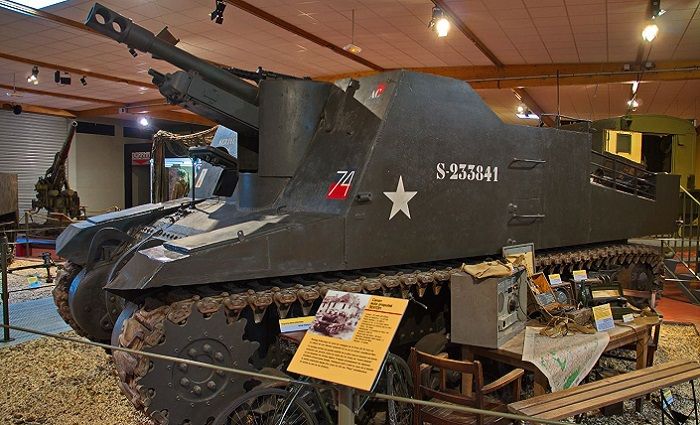
The Memorial Museum of the Battle of Normandy is a top place to see at Normandy. Bayeux is around 20 miles west of Caen on the inland side. This ancient city also hosts the famous Bayeux Tapestry.
Wondering what that is? Well, it’s not a tapestry at all but a famous embroidery that tells the story of the invasion of England by William the Conqueror. Thus, it seems apt that Bayeux would also tell the story of a more recent, historic invasion.
Bayeux’ museum focuses solely on the Battle of Normandy. Part of Operation Overlord, the Battle of Normandy took place over the summer of 1944. After the successful but bloody D-Day invasion, Allied troops pushed southeast across Normandy to the Seine river.
Their goal was to liberate Paris, and according to WWII historian Stephen Ambrose, Paris was liberated on August 25. The Germans retreated across the river to the east on August 30, 1994. That fateful event marked the end of Operation Overlord.
Address: Bd Fabian Ware, 14400 Bayeux
Closed: Annually in January
Cost: starting at €7.50 (buy in person only)
6. Artificial Harbor at Arromanches
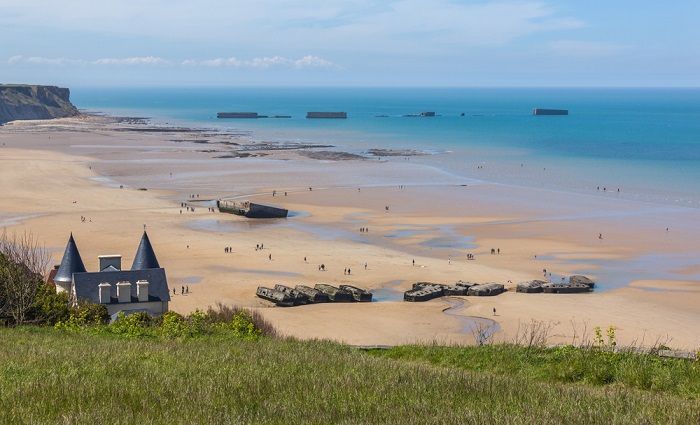
You might wonder how the Allied forces moved their vehicles and cargo across the English Channel and onto the shores of France. A key piece of their success was the genius installation of two portable, temporary harbors.
They named the first harbor at Omaha Beach Mulberry A. Then they built Mulberry B at Arromanches-les-Bains on Gold Beach. Today, you can see remnants of Mulberry B in Arromanches—the very same harbor the Allies used for over 10 months after D-Day. Incredibly, 2.5 million troops and 4 million tons of supplies came through Mulberry B, notes historian Jonathan Falconer.
A 17-minute drive from Bayeux gets you to scenic Arromanches. You have a splendid view of the artificial harbor from above. While you cannot walk on the remaining constructions, at low tide you can get quite near them. If you arrive around lunchtime, I recommend having fresh seafood at Restaurant La Maison du 6. It’s just a short walk from the main square on Cale Neptune.
Address: 14117 Arromanches-les-Bains
Cost: FREE
Not ready to book a tour? Find out how to visit the Normandy D-Day sites.
5. 360° Theater at Arromanches
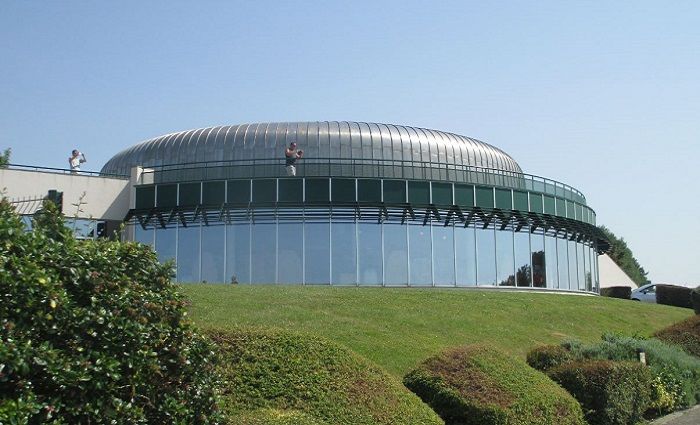
The impressive 360° Circular Cinema lies on the ridge above the city. The view of the artificial harbor and beach is stunning. So is the 20-minute film you’ll see in this remarkable theater.
“The 100 Days of the Battle of Normandy” is a breathtaking movie montage of footage from multinational archives. The film begins with the D-Day landings. It is projected on nine different screens, which place you at the center of the action. The experience is intense and deeply moving.
Address: Rue du Calvaire, 14117 Arromanches-les-Bains
Cost: starting at €6
4. Omaha Beach
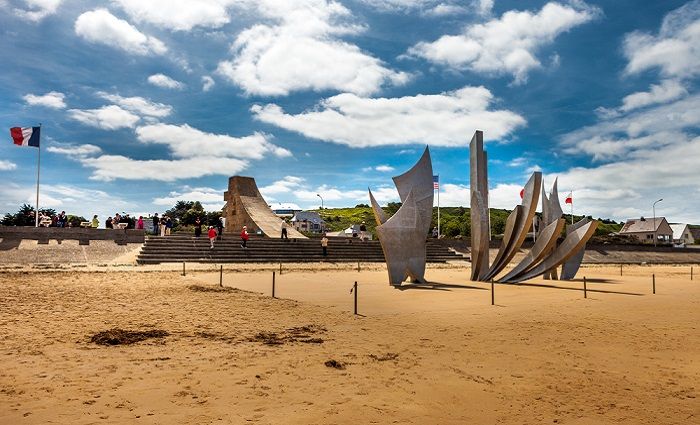
It goes without saying that Omaha Beach can’t be missed at the Normandy beaches. The Allied forces decided to call the beach landing part of the attack Operation Neptune. They designated five beaches as landing zones, and Canadian and British soldiers landed at Juno, Gold, and Sword beaches.
However, the Americans’ entry points were Omaha and Utah beaches, explains Ambrose. That’s just part of why these two beaches are the most recognized by Americans. But it’s also because the most intense fighting on D-Day took place on Omaha Beach.
The Germans had a superior position on the cliffs overlooking the beach, including concrete bunkers. In contrast, the invading troops had to enter the beach from the water—completely exposed. As a result, 2,400 lives were lost, according to the Department of Defense records. However, untold lives were saved by their heroic sacrifices. Today, Omaha Beach is peaceful—there is no sign of the violence and bloodshed of June 6, 1944, and the days that followed.
I recommend taking the D514 road parallel to the sea to get to Omaha Beach where visitors are free to explore. Whereas once you could walk down to the beach from the Normandy American Cemetery above, you must now arrive via Saint-Laurent-sur-Mer. Upon arrival, you’ll see the massive memorial sculpture titled Brave. It looks like gleaming silver swords and tongues of fire.
Address: Av. de la Libération, 14710 Saint-Laurent-sur-Mer
Museum Cost: starting at €5
3. Normandy American Cemetery and Memorial
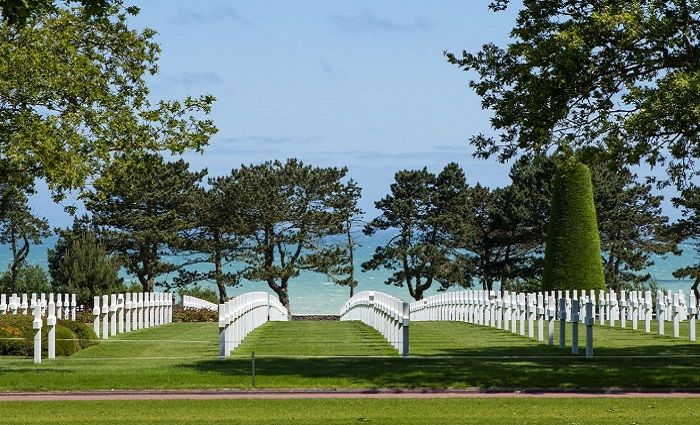
The Normandy American Cemetery and Memorial is located in Colleville-sur-Mer. According to the American Battle Monuments Commission, the Army constructed it on the site of a temporary cemetery for American soldiers in June of 1944. It was the first American cemetery on European soil in World War II. The 172.5 acre cemetery contains the graves of 9,386 dead. Most of the fallen died on D-Day and the days of battle that followed.
The Walls of the Missing on the east side of the memorial enclose a quiet, semicircular garden. The 1,557 names of the missing have been inscribed on those walls, and it’s worth taking some time to see it. Sculptures and large maps describe the military operations that took place in Normandy.
There is a beautiful reflecting pool and a small chapel. To the north, rising above the ocean, a table with a diagram of the beaches is available to help orient visitors. However, the lines of austere white crosses are by far the most poignant aspect of the cemetery and likely what you came to see here at the American Cemetery.
Address: Rte du Cimetiere Americain, 14710 Colleville-sur-Mer
Cost: FREE
2. La Pointe du Hoc
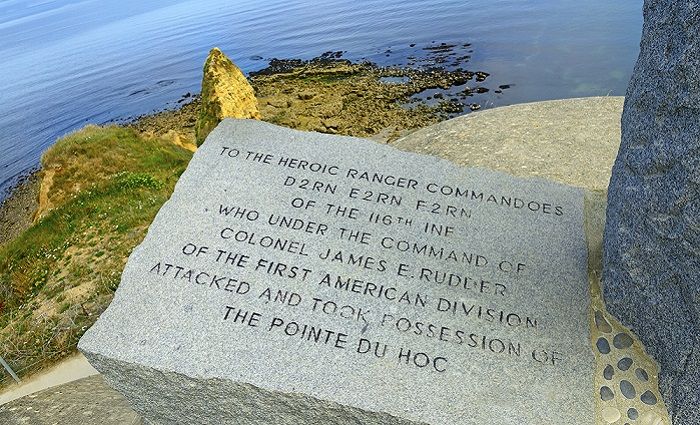
Drive further west of Omaha Beach for 15 minutes and you’ll reach La Pointe du Hoc. As a cliff overlooking the English Channel, Pointe du Hoc was enormously strategic for the Germans.
They had fortified it and built concrete bunkers that seemed completely impregnable. It was their front-row seat for the invasion of Normandy. Thus, the Allies knew that its position would prove a dire threat to the success of the invasion and determined to conquer it at all cost.
The massive battle that took place there left scars that you can still see today. As you stand at Pointe du Hoc, you’ll see huge craters created by the awe-inspiring and deadly assault of the Allied forces. The site is unimaginably eerie. You can walk alongside the craters and even climb down into the bunkers to get a feel for what it might have been like to stand guard there.
Address: 14450 Cricqueville-en-Bessin
Cost: FREE
1. Utah Beach and Landing Museum
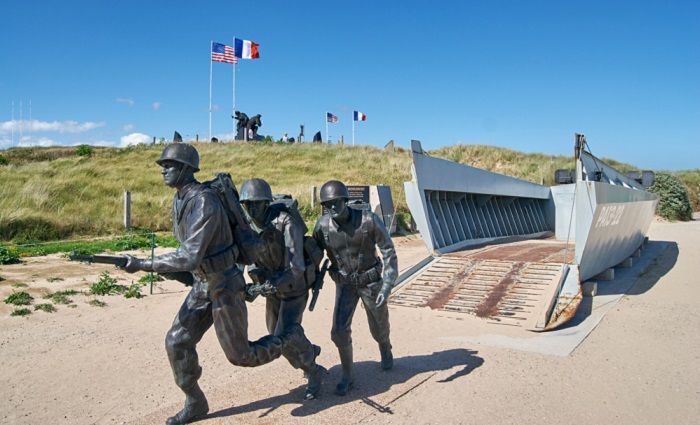
If you drive about 35 or 40 minutes west of Pointe du Hoc, you will reach the Cotentin (or Cherbourg) Peninsula where Utah Beach is located. Utah was the furthest west of the D-Day beaches. The decision to attack this beach was a late addition to the planning stages, notes Ambrose. Yet, it proved to be strategically essential due to its close proximity to the deep water port at Cherbourg.
Utah Beach was the first place the Allies landed on June 6, 1944. According to the Department of Defense, they only lost 197 men of the 23,000 troops who deployed on there. However, they succeeded in taking the beach and establishing a beachhead.
The Musée du Débarquement Utah Beach, or the Utah Beach Landing Museum, is another top place to see when you visit the Normandy D-Day beaches. First, the architecture of the museum integrates with the beach thanks to the huge windows that provide an immense view. You can’t forget where you are.
Second, the museum’s extensive collection of vehicles, equipment, and objects really gives you important context to the tragedy and heroism that occurred here at these sacred sites. Your trip to the Normandy D-Day beaches, museums, and cemeteries will be one to remember.
Address: La Madeleine, 50480 Sainte-Marie-du-Mont
Museum Cost: starting at €5
Not ready to book a tour? Find out if a tour of Normandy’s D-Day beaches are worth it.
